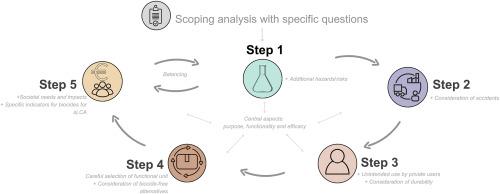为使欧盟委员会的安全及可持续设计框架适用于杀菌剂而提出的建议
IF 5.8
2区 化学
Q2 CHEMISTRY, MULTIDISCIPLINARY
引用次数: 0
摘要
欧盟委员会发布了一个安全与可持续设计框架(SSbD),以尽量减少化学品和材料的不利影响。杀菌剂是一类重要的活性物质,对生物具有预期的作用,被广泛使用,无论是专业还是公众。杀菌剂由于其对生物体的预期影响,代表了一组化学物质,对SSbD框架提出了特殊的挑战。由于杀菌剂故意表现出有害的特性以提供社会效益,因此需要一种特殊的方法来评估其安全性和可持续性。因此,我们建议对SSbD框架进行特定于杀菌剂的修订,以应对这些挑战,从而进行更平衡的评估。首先,我们建议在范围分析中包含具体问题。此外,建议采用具有中心方面的循环方法进行评估,以促进对杀菌剂的安全性和可持续性考虑的反复改进。核心方面包括目的、功能和功效。此外,还针对安全性和可持续性分别提出了具体建议,包括在社会影响评估步骤中针对生物杀灭剂具体方面提出的第一个建议;包括社会需求和影响(积极和消极方面)以及社会经济生命周期评估。建议在社会需求和影响与内在危害评估之间建立一个反馈回路,这涉及到平衡危害与所调查的杀菌剂的功能。本研究的一些建议也可能适用于其他活性物质、化学品和材料,作为SSbD框架的一般建议。本文章由计算机程序翻译,如有差异,请以英文原文为准。

Recommendations for making the European Commission's Safe and Sustainable by Design framework practicable for biocides
The European Commission has published a framework on Safe and Sustainable by Design (SSbD) to minimize the adverse impacts of chemicals and materials. Biocides are an important group of active substances with an intended effect on organisms that are widely used, both professionally and by the general public. With their intended effects on organisms, biocides represent a group of chemicals for which the SSbD framework presents particular challenges. As they intentionally feature harmful properties to provide a societal benefit, a special approach is needed for biocides to assess their safety and sustainability. Thus, we propose biocide-specific amendments to the SSbD framework to address these challenges, allowing a more balanced assessment. First of all, we suggest the inclusion of specific questions within the scoping analysis. In addition, a circular approach with central aspects is recommended for the assessment to facilitate an iterative improvement of safety and sustainability considerations for biocides. The central aspects include purpose, functionality and efficacy. Additionally, specific recommendations are provided for safety and sustainability individually, including the first proposals for biocide-specific aspects in the social impact assessment step; encompassing both societal needs and impacts (positive and negative aspects) and a socio-economic life cycle assessment. It is advisable to establish a feedback loop between societal needs and impacts and the intrinsic hazard assessment, which involves balancing the hazard with the functionality of the investigated biocide. Some suggestions from this study may also apply to other active substances, chemicals and materials, serving as general recommendations for the SSbD framework.
求助全文
通过发布文献求助,成功后即可免费获取论文全文。
去求助
来源期刊

Sustainable Chemistry and Pharmacy
Environmental Science-Pollution
CiteScore
8.20
自引率
6.70%
发文量
274
审稿时长
37 days
期刊介绍:
Sustainable Chemistry and Pharmacy publishes research that is related to chemistry, pharmacy and sustainability science in a forward oriented manner. It provides a unique forum for the publication of innovative research on the intersection and overlap of chemistry and pharmacy on the one hand and sustainability on the other hand. This includes contributions related to increasing sustainability of chemistry and pharmaceutical science and industries itself as well as their products in relation to the contribution of these to sustainability itself. As an interdisciplinary and transdisciplinary journal it addresses all sustainability related issues along the life cycle of chemical and pharmaceutical products form resource related topics until the end of life of products. This includes not only natural science based approaches and issues but also from humanities, social science and economics as far as they are dealing with sustainability related to chemistry and pharmacy. Sustainable Chemistry and Pharmacy aims at bridging between disciplines as well as developing and developed countries.
 求助内容:
求助内容: 应助结果提醒方式:
应助结果提醒方式:


